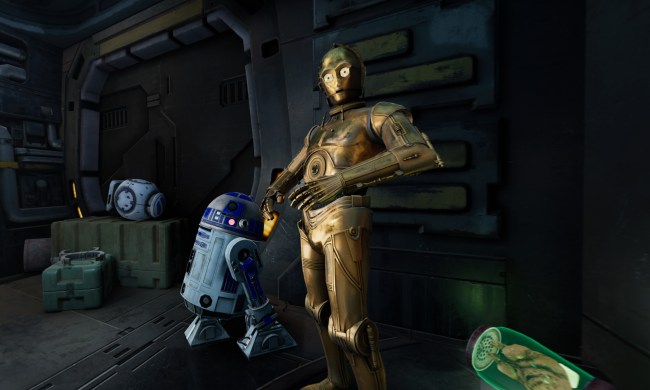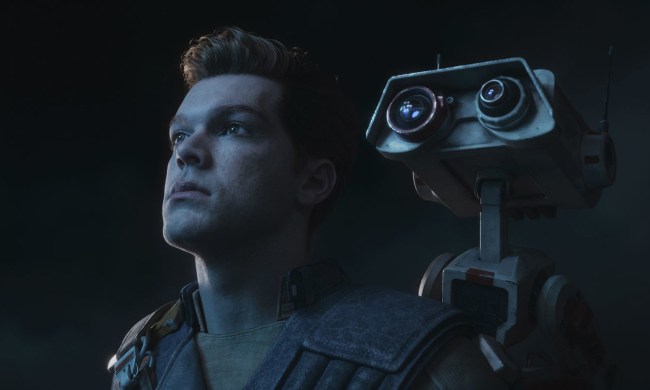When ILMxLAB learned about the PlayStation VR2, Director Jose Perez III thought it was a "no-brainer" for the studio to bring the Oculus Quest game Star Wars: Tales from the Galaxy's Edge to the new headset.
"We're always looking at how we can push the fidelity of the work that we're doing," Perez III tells Digital Trends in an interview. "PlayStation VR2 is ridiculously powerful; we got really excited about what we could bring to that. We started talking with our friends at Sony because we had a great relationship with them for Vader Immortal, and it was really a no-brainer. Then, you put the headset on, you start feeling the haptics, and you start seeing what you can do with the visual fidelity and lighting, and it's like, 'Oh, this is awesome!'"
Star Wars: Tales from the Galaxy's Edge - Enhanced Edition | Official Trailer | PS VR2
PlayStation VR2's launch and its first wave of games are nearly upon us, and Star Wars: Tales from the Galaxy's Edge Enhanced Edition is one of those titles. This is a make-or-break time for VR, which is still struggling to move into the mainstream but could become more popular if Sony's headset can offer a compelling and accessible virtual reality experience. Ahead of its release, Digital Trends spoke to Director Jose Perez III and Producer Harvey Whitney from ILMxLAB to learn about the process of crafting one of these critical "no-brainer" launch games and PlayStation VR2 will ultimately stand when it comes to the future of VR gaming.
The power of PlayStation VR2
Star Wars: Tales from the Galaxy's Edge was originally released for Meta Quest VR headsets in November 2020. It's set on the planet of Batuu, which people also explore at Dinsey parks, and follows a Droid Technician who gets caught in the middle of a grander fight against the First Order after crash-landing on the planet. At the time, it was meant with decent reviews and only got better as its story was completed and expanded with the Last Call DLC.
After getting the "Enhanced Edition" of the game for PlayStation VR2 greenlit, ILMxLAB actually had to go and make it. As the team was dealing with new hardware for the first time, producer Harvey Whitney thought it was good that the team's first project on PlayStation VR2 was an enhanced version of an existing game.
"Early on, knowing that we already had the content that was created for the original, that changes things quite a bit," Whitney tells Digital Trends. "We're not redeveloping the story and coming up with all of that. We just had that opportunity to work as a team and ask, 'What do we really push here, and where are the changes that we want to make, and what we can do to really take advantage of this hardware?'"
The VR space is full of different headsets with unique specs, with the much higher specs of the PS VR2 standing out. The PlayStation VR2 sports some impressive specs compared to its VR peers, displaying content in a 4000x2030 HDR format at a 90Hz or 120Hz frame rate. Plus, games have the PS5's power, spatial, and brand new Sense controllers to take advantage of, rather than the 2013 console and 2010 motion controls that limited the original PlayStation VR.
PlayStation VR2 supports Roomscale, Sitting, and Standing play styles, which added more complexity as Tales from the Galaxy's Edge supports all three. Thankfully, Perez III that bringing Tales from the Galaxy's Edge to PlayStation VR2 was relatively manageable because of how impressive the system's specs were.
"A lot of the development processes are similar [to other VR platforms]," Perez III says. "We're still working inside of Unreal, and we're doing a lot of those same processes. But we don't have to look at performance quite as much as we do on some of the other devices, so we're able to open up a lot of things or not be as concerned about certain things. That comes with better hardware."
Better hardware, better games
Looking at the biggest games of the PlayStation VR2 launch window lineup, the visuals of titles like Horizon Call of the Mountain and the VR modes of Resident Evil Village and Gran Turismo 7 are impressive. In our discussion, Whitney also made it quite clear that one of the real advantages of working on this remaster was not having to worry about strict limitations on the visuals or even the audio. "We got lucky in the sense that there's a lot more to PlayStation VR2 that we hadn't had previously," Whitney says. "We could really push the graphics and make it shine. But then there were also some other things that came into play. We totally redid the audio, it sounds amazing."


